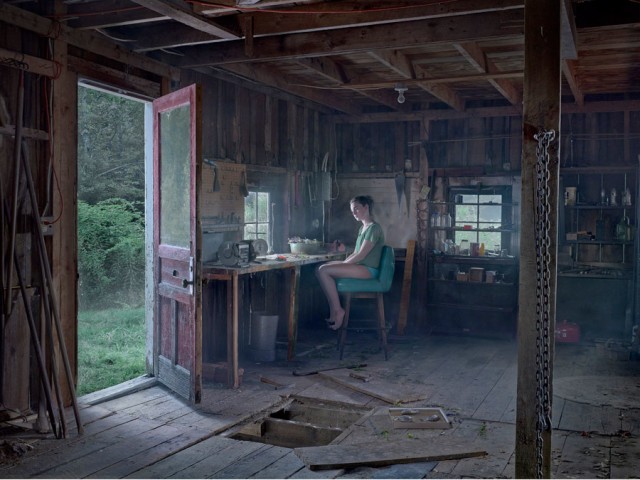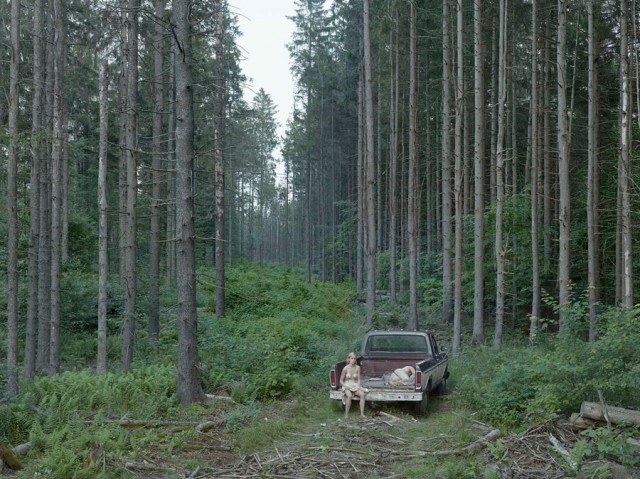
Gregory Crewdson, “The Barn,” digital pigment print, 2014 (© Gregory Crewdson)
Gagosian Gallery
522 West 21st St. between Tenth & Eleventh Aves.
Extended through Saturday, March 12, free, 10:00 am – 6:00 pm
212-741-1717
www.gagosian.com
In Ben Shapiro’s 2012 documentary, Gregory Crewdson: Brief Encounters, Brooklyn-born photographer Gregory Crewdson says, “My pictures are about a search for a moment — a perfect moment.” In such series as “Twilight,” “Dream House,” and “Beneath the Roses,” Crewdson captures that critical in-between moment, creating fictional cinematic images in which something seems to have just happened, or is about to happen, but he leaves it up to viewers to create their own narratives. Those were followed by “Sanctuary,” in which he photographed abandoned sets at the Cinecittà studios in Rome, black-and-white shots of postapocalyptic architecture devoid of people. It was almost as if he was saying goodbye to his movie-like oeuvre, his trademark style that was part Alfred Hitchcock, part David Lynch. For two years, while going through a painful divorce, Crewdson did not pick up his camera, but he’s back with an intimate, personal series, “Cathedral of the Pines,” taken in and around his new home in Becket, Massachusetts. The large-scale photographs, each one 37.5 x 50 inches framed, focus on seemingly downtrodden friends and relatives, including his daughter, Lily, his new partner, Juliane Hiam, and Hiam’s children, in contemplative poses under an arched bridge, on the back of a pickup truck, in a living room, in a kitchen, in a barn. The crystal-clear, deep-focus photos combine the indoors and the outdoors, human figures and nature, as the subjects look forlornly into an imaginary abyss. The men and women are surrounded by snowy mounds, lush green trees, a rolling river. As opposed to Crewdson’s previous series, in which the photos were like movie stills, these Hopper-esque scenarios capture heart-rending moments that are palpable, that feel like they come closer to approaching reality than his more fantastical creations, like we’re intruding on these people’s difficult, domestic lives, like we have compromised their privacy.

Gregory Crewdson, “The Pickup Truck,” digital pigment print, 2014 (© Gregory Crewdson)
In “Reclining Woman on Sofa,” a naked woman lies on a couch, her body mimicking the icy pond out her window. In “The Motel,” a distraught couple sits on a porch, almost disappearing into the snowy scene. In “Seated Woman on Bed,” a woman in a nightgown waits on the corner of her bed, part of her visible in a mirror, the blanket arranged to show that she slept alone. And in “The Shed,” a woman stands outside the door of a nearly empty wooden shed, her hands coated in mud, her head down, as if giving up. The photos might be wrapped in sadness, as if the subjects are all dealing with some kind of loss, but there is a serene beauty to them. “It was deep in the forests of Becket, Massachusetts, that I finally felt darkness lift, experienced a reconnection with my artistic process, and moved into a period of renewal and intense creative productivity,” Crewdson says about the series, which in many ways is a natural progression, a culmination, of everything he has done before. What comes next for the photographer? In October 2006, Crewdson told the Guardian, “I think I’d be a terrible movie maker because all I know is the one image. I’m not really that interested in the before or after. I want the story to remain unresolved.” But Crewdson appears to not be done with cinema quite yet; it was recently announced that he and Hiam will adapt Carla Buckley’s The Deepest Secret into a film.